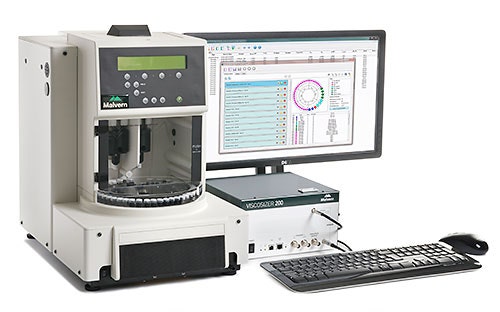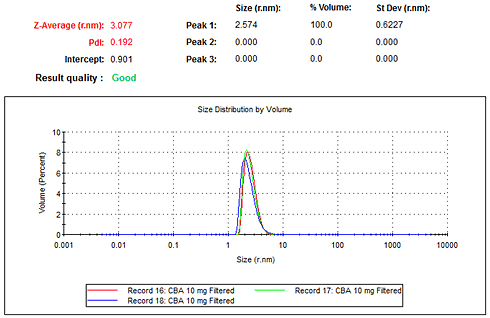The new Malvern Viscosizer 200 is primarily designed to automate the rapid measurement of viscosity in very low sample volumes. However, it is also capable of measuring molecular size and this application note highlights that capability.
Sizing proteins and other molecules by light scattering technologies such as static light scattering (SLS) or dynamic light scattering (DLS) can be challenging at very low molecular size and concentration, or in the presence of large precipitates or contaminants. The Viscosizer 200 employs UV area imaging and Taylor Dispersion Analysis to determine the molecular diffusion coefficient and to calculate hydrodynamic radius in a novel way that can help overcome these obstacles. The Viscosizer 200 uses advanced microcapillary technology, is very low in sample consumption (< 10 nL label-free), and is compatible with complex solvents and buffers, biological matrices, colored solutions and samples which contain aggregates or contaminants. The instrument can detect very low concentrations: > 0.2 mAU equivalent to < 0.05 mg/mL lysozyme.
This application note evaluates protein and small molecule sizing analysis by the Viscosizer 200 and explains how this technology complements light scattering technologies in the protein characterization workflow.

|
Bovine carbonic anhydrase (Sigma Aldrich, Poole, UK) was prepared to a final concentration of 10 mg/mL in 10 mM HEPES buffer.
The 10mM HEPES buffer was prepared by diluting 1 M HEPES stock solution (Sigma Aldrich, Poole, UK) with Fresenius sterile water (Fresenius Kabi, UK) and adjusting to pH 7 with 0.25 M hydrochloric acid or 0.5 M sodium hydroxide.
Caffeine (Sigma Aldrich, Poole, UK) was prepared at 1 mg/mL with Fresenius sterile water (Fresenius Kabi, UK) and sterile-syringe filtered to 0.02 µm (Fisher Scientific, 50-822-149).
Warfarin (Sigma Aldrich, Poole, UK) was prepared to 0.1 mM and 10 mM in 100% dimethyl sulfoxide (DMSO) and sterile-syringe filtered to 0.02µm (Fisher Scientific, 50-822-149).
All measurements were carried out at 25 OC and instrument settings were adjusted where required to compensate for buffer viscosity. The Viscosizer 200 was fitted with a 214 nm UV filter.
10 mg/ml carbonic anhydrase (CBA) was analyzed using the Viscosizer 200 (see Figure 2). The hydrodynamic radius (RH) was measured as 2.7 nm. This size was confirmed by measurement of the same solution on the Zetasizer Nano ZSP after filtration. This highly sensitive industry standard instrument uses the proprietary Non-Invasive Back Scatter (NIBS) technique to accurately measure the size of molecules in solution. Figure 3 shows that the RH is measured by the Zetasizer Nano ZSP as 2.6 nm, in very close agreement with the value of 2.7 nm obtained using the Viscosizer 200. This demonstrates that the Viscosizer 200 can be used orthogonally to provide accurate size data for unfiltered, unmodified and undiluted samples.

|

|
The Viscosizer 200 uses highly sensitive UV area imaging to detect UV-active molecules within a sample. This makes the technique perfect for the investigation of UV-absorbing small molecules which are not suitable for analysis by DLS because of their small size. The instrument was used here (see Figure 4) to measure the hydrodynamic radii of caffeine (194.19 g/mol) and warfarin
(308.33 g/mol).

|

|
Figures 4 and 5 show the results of small molecule size analysis by the Viscosizer 200. The control, 1 mg/mL caffeine in water, is sized correctly at 0.32 nm RH. Warfarin is estimated to have a radius of 0.5 nm, so the measured value of 0.46 nm in DMSO is within the expected range.
The Viscosizer 200 is a novel analytical instrument which can be used orthogonally with dynamic light scattering systems for sizing applications. It can measure the size of proteins accurately and reproducibly, even in the presence of aggregates, when filtration is not an option. Sizing by mass-weighted UV absorbance makes the system ideal for measuring small molecules > 100 Da at low concentrations, which may prove challenging for light scattering techniques.